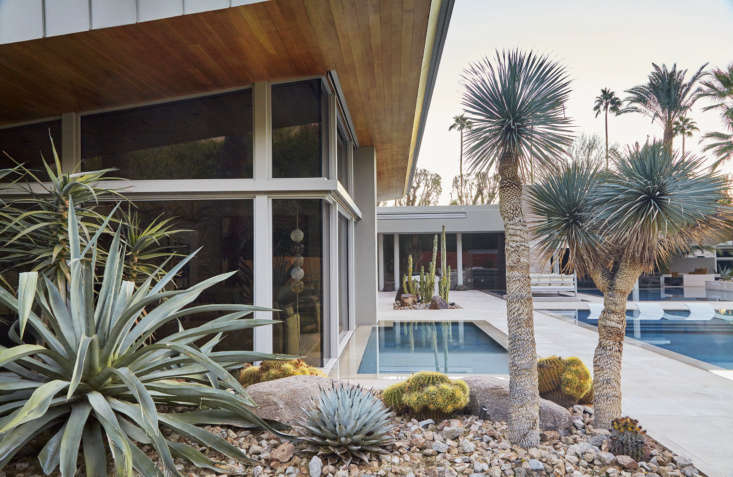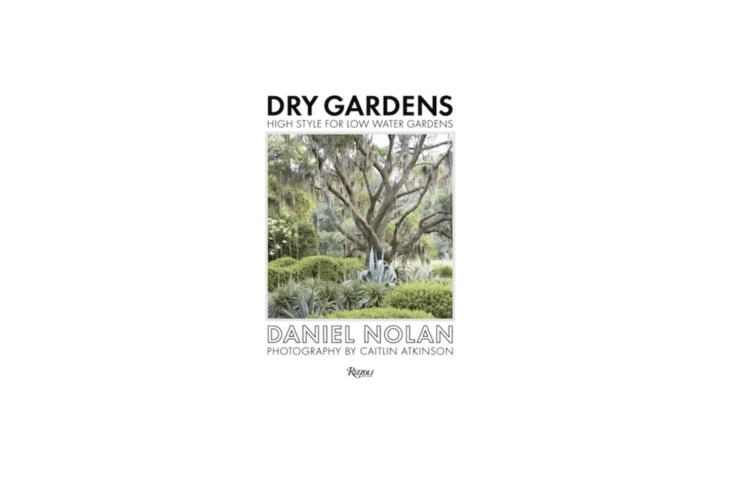Please forget everything you think you know about dry gardens (especially if you are imagining harsh, spiky, half-dead-looking landscapes).
A low-water garden can have lush foliage, soft textures, and will welcome you into deep, luxurious shades of greens if Northern California-based landscape designer Daniel Nolan created it. Nolan, who made his name as an inventive in-house designer at San Francisco’s beloved Flora Grubb Gardens and is founder of the eponymous Daniel Nolan Design, recently collected 25 favorite projects (including some of his own) in a book, Dry Gardens.
Before he starts a new landscape project, Nolan says he “will ask myself: Is there a way we can reduce the water consumption?” Nolan’s gardens answer the question with personality, style, and an approachable feel. An expert on container gardens, as well, Nolan chooses plants that can thrive in dry soil with infrequent irrigation.
When we asked Nolan to share his secrets for designing a dry garden, he offered eight tips (illustrated beautifully in his book, with photographs by Caitlin Atkinson):
Photography from Dry Gardens, courtesy of Rizzoli.
1. Reduce the size of your lawn.

How do you reduce the size of your lawn? Nolan doesn’t oppose lawns, but he is considerate of appropriate sizes and scale. “Take any opportunity to expand your planting beds,” says Nolan. “Try spreading out your plants to give them ample room and show them off by selecting a gravel that contrasts and highlights their shape.”
2. Accessorize a swimming pool with sculptural silhouettes.

How do you add drama to the landscape surrounding a swimming pool? “Don’t be afraid to experiment with your ground cover selections beyond mulch,” says Nolan. “I think selecting the right stone is as important as the plant selection, a bigger rougher stone or Mexican pebble will make your plants standout.”
3. Add native plants (they’ll naturally thrive in your climate).

Texas natives thrive along this entrance border. “What makes it successful is that four plants are kept in graphic lines, the height of the oaks, the softness of the grasses, the texture of the prickly pear and the ground cover tying it all together,” says Nolan.
How do you create the right mix of native and non-native species in a dry garden? “Request natives. While most large commercial nurseries don’t carry a wide selection of native species to the area, smaller nurseries usually have a better selection and can point you towards plants that thrive in the local climate,” says Nolan.
4. Make a small garden feel larger, with layering.

Nolan believes that not all gardens need to be bone dry. A good mix of plants—including those which significantly reduce water consumption and others that are a bit more thirsty—is fine.
How do you create a layered look in an existing garden? “When you’re looking to add to your already-established garden, steer clear of heavy water consumers and look to either native or drought tolerant species,” says Nolan.
5. Embrace harsh beachfront climates, with succulents.

Nolan says, “Beach-front properties can be hard, and this one is so masterfully done because it’s three textures: a solid hedge of dwarf olive mixed with a lush agave and succulent garden and the Mexican feather grasses make it informal and add movement.”
What are perfect plants to choose for seaside gardens? “Succulents are perfect for seaside gardens because that is where most succulents are native to around the world and are able to handle not only the sun but the near constant wind and salt air,” says Nolan.
6. Don’t dismiss the obvious choices for container gardens.

When considering plants for your home or office, the ability for your leafy addition to be fuss-free and still survive after being potentially neglected are a must. “The sansevieria gets a bad wrap for being predictable when it’s really the chicest of interior plants,” says Nolan. “There are now dozens of varieties and doing a few varieties gives you a cool mix of colors and textures. Add a few cactus to the mix and it’s a garden you can enjoy with minimal care.”
What are common houseplants you also can choose for outdoor container gardens? “Mother-in-law’s tongues are the workhorses of houseplants, and combined with Cleistocactus, you will have a lush planting that requires almost no maintenance with minimal watering,” says Nolan.
7. Rely on already-established plants to create privacy.

Well-established bamboo (shown above) was left in place because it thrived in the clay and provided an efficient screen, but Nolan says, “We ended up removing a large patch of grass and installing the Phoenix dactylifera to give the pool a graphic element, and added the soft Acacia iteaphylla to create another layer.”
Why should you try to work around established plants when designing a dry garden? “Leave established plants because the longer an ornamental plant has grown in, the less water it needs,” says Nolan.
8. Say hello to the overlooked aloe.

This small space project feels cohesive because of “the repetition of specific plants in their containers and a muted color palette,” says Nolan.
Why should you include aloes (which are often overlooked) in a dry garden? “They offer scale in any desired application, from tree aloes to ground cover varieties,” says Nolan. “There are dozens of bloom colors as well, which contradicts the notion that dry gardens are not colorful.”

See more ideas for design dry gardens in our curated guides to Hardscape 101, including special sections on Gravel 101 and Decks & Patios 101. See more of Nolan’s gardens (and more tips for Dry Garden Design):
- Designer Visit: A Garden Hidden in SF’s Mission District, by Daniel Nolan
- Required Reading: Succulents, The Ultimate Guide
- Landscaping Ideas: 8 Surprising Ways to Use Corten Steel in a Garden
- Expert Advice: 11 Tips for Gravel Garden Design
- Can This Garden Be Saved: “It Barely Rains; I Live in a Desert”
- Steal This Look: An Outdoor Living Room in SF, Heated Sofa Included








Have a Question or Comment About This Post?
Join the conversation